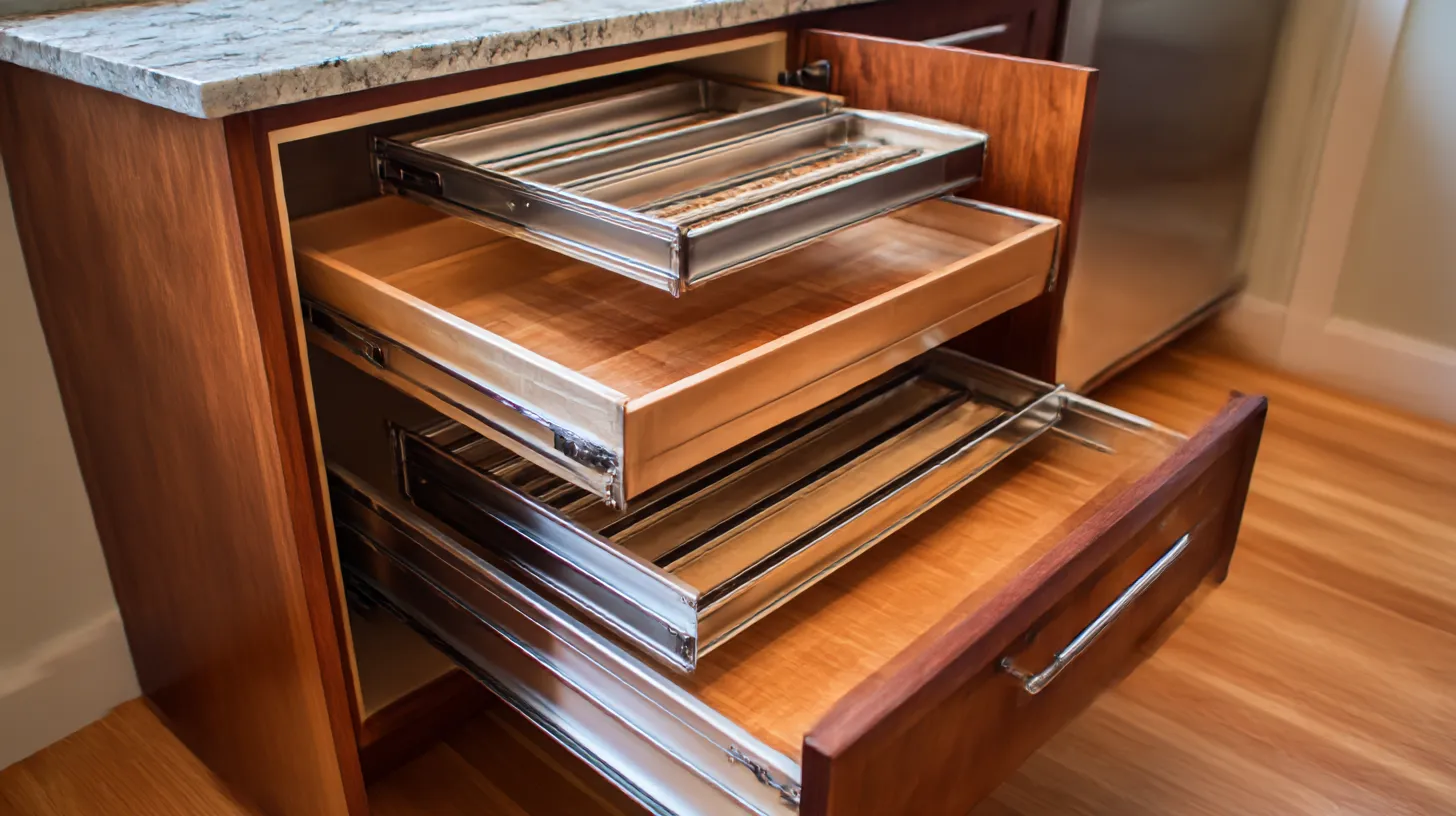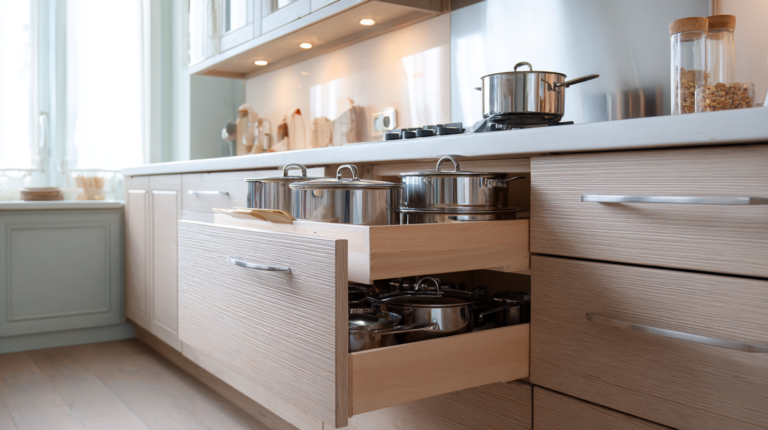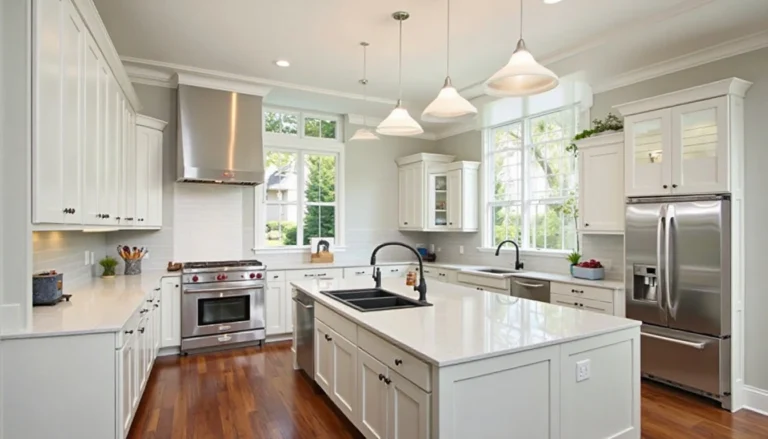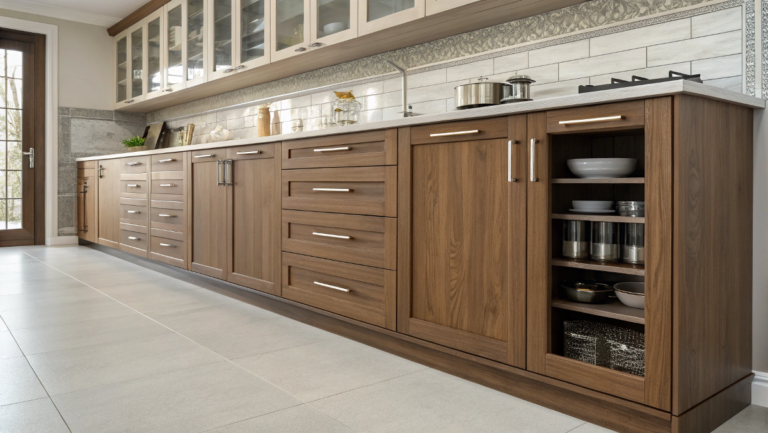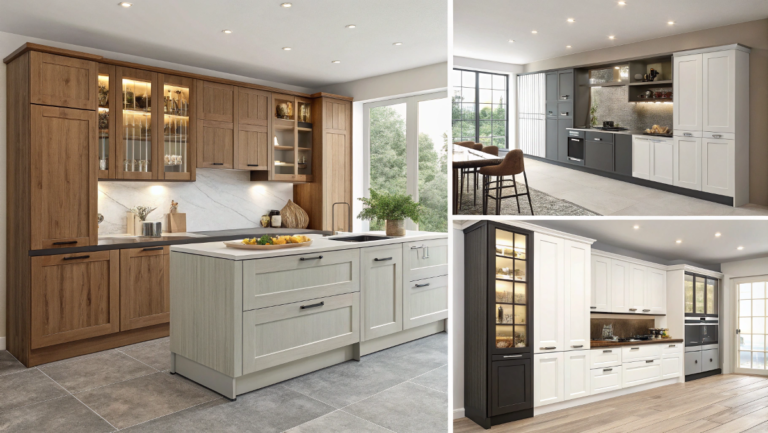Cabinet Pull-Out Shelves, Real-Life Guide for DIY Wins
It started with a cabinet and a colander.
More specifically, me halfway inside a lower cabinet, muttering under my breath, elbow jammed against a can of beans while trying to reach a colander that somehow migrated to the back. That’s when I finally said it out loud: “I need cabinet pull-out shelves.
Not in a Pinterest-dream-renovation kind of way. In a please save me from this chaos before I throw my back out kind of way.
I used to think cabinet pull-out shelves were a luxury, something reserved for custom kitchens and people who actually measure things right the first time. But let me tell you, they’re for people like us. The messy. The practical. The ones who just want to find a dang pot lid without minor injury.
This is everything I learned (the hard way) about choosing, installing, and living with pull-outs that actually make your kitchen feel… functional. And maybe even a little fancy
Cabinet pull-out shelves are sliding trays installed inside your cabinets to make items easier to access. They help reduce clutter, prevent strain from bending, and improve kitchen organization by allowing you to see and reach everything without digging. Ideal for base cabinets, pantries, or under-sink areas, pull-out shelves can be added without a full remodel and are available in wire, wood, and soft-close styles to fit different needs and budgets
What Are Cabinet Pull-Out Shelves, And Do You Actually Need Them?
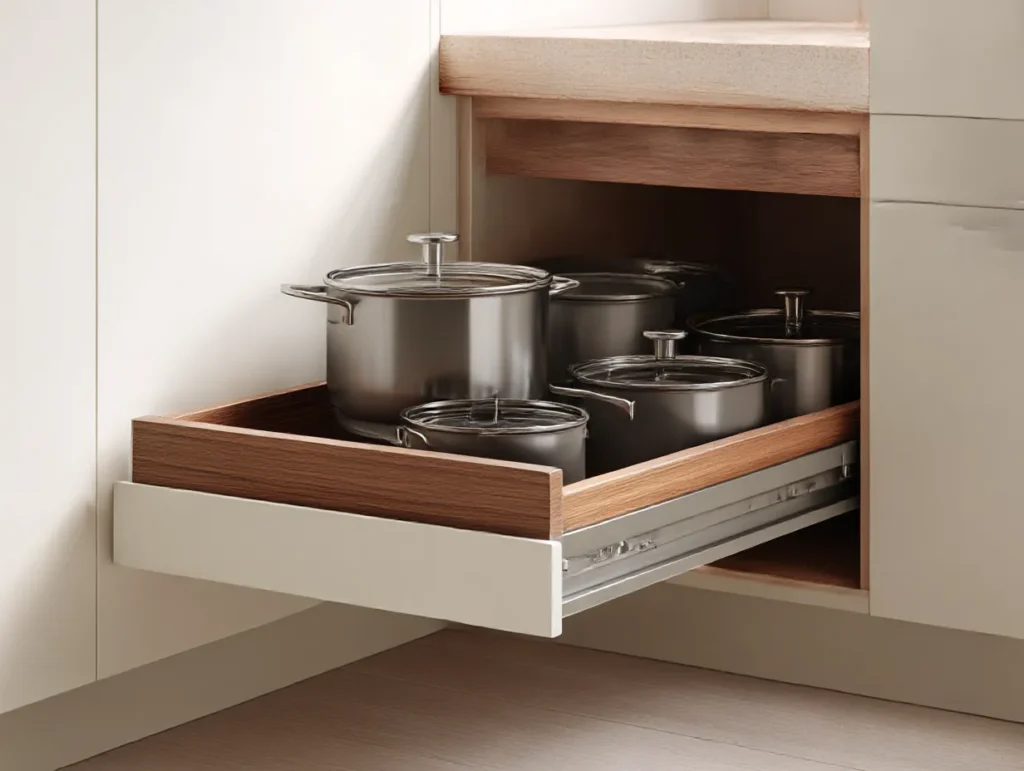
Let’s be honest, cabinet pull-out shelves” sounds like something a fancy contractor might say while sipping designer coffee in a showroom with LED-lit spice drawers. But in real-life kitchens like mine (read: tight corners, toddler fingerprints, and a drill that wheezes louder than I do after stairs), they’re just a smarter way to not lose your mind.
So, what are cabinet pull-out shelves?
Think of them as slide-out trays that live inside your cabinets. Instead of bending, squatting, and practically climbing into your cupboards like you’re hunting for buried treasure, you just pull a shelf forward. Boom, everything’s right there. No more head-bumps. No more mystery lids. Just visibility, baby.
I didn’t understand the magic until I saw my neighbor Sarah glide out a double-tier shelf with her pinky finger like it was no big deal. (It was a big deal. I may have gasped.) Suddenly, my cluttered cabinets felt like some kind of medieval punishment.
Who actually needs these?
-
Busy home cooks juggling hot pans and lost utensils
-
Parents who need fast access (because no one wants to unstack five pots at dinner time)
-
Aging parents or bad backs (hi, Dad!), way less bending
-
DIYers like me who love a small win with a big impact
-
Organizational freaks (no shame!) who label everything and want it to stay organized
Here’s what I wish someone had told me: pull-out shelves don’t have to be expensive or complicated. You can start with one tray under your sink for like $30 and instantly feel 30% more in control of your life. (Not scientifically verified, but spiritually true.)
Do Pull-Out Shelves Work for Every Cabinet?
Mostly yes, but there are a few catches. Cabinets with pipes (hello, under-sink chaos), narrow openings, or off-center doors can be tricky. I’ll break down the gotchas in a later section, but the short answer? If you can open the cabinet and slide a tray out 3/4 of the way, you’re probably good to go
The 4 Types of Cabinet Pull-Out Shelves You’ll Use
So before I even attempted to buy my first pull-out shelf, I fell into what I now call the “slide trap.” That’s where you realize there are, like, seventeen different types of cabinet pull-out shelves, all promising to change your life, and you’re left Googling things like “soft-close vs. full-extension” while your pasta water boils over.
Let me save you the brain fog. These are the four types you’re most likely to use, and the real-life pros and cons of each (from someone who messed up a few of them).
1. Wire Basket Pull-Out Shelves
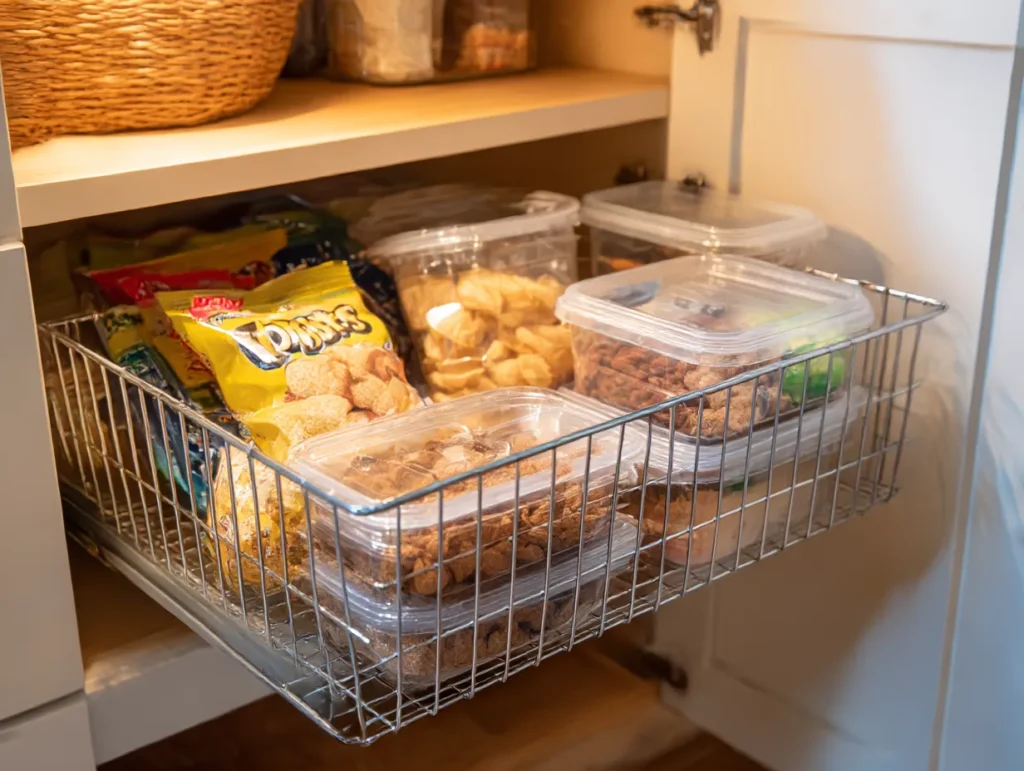
-
What they are: Open metal baskets on gliders
-
Best for: Pantry items, snacks, plastic containers
-
Pros: Affordable (I got a 2-pack for $47 at Lowe’s), breathable, easy to clean
-
Cons: Stuff can tip through the gaps, not great for tiny jars or sauce packets
-
Maya’s take: Great for kid snacks. Just don’t expect them to contain rogue juice boxes.
2. Wooden Pull-Out Trays

-
What they are: Solid wood or plywood trays with sides
-
Best for: Pots, pans, small appliances
-
Pros: Sturdy, pretty, won’t let stuff fall through
-
Cons: Heavier, pricier (mine cost $68 each), require precise measuring
-
Maya’s take: Love the look. Hate the math. Worth it if you’re doing a permanent upgrade.
3. Double-Tier Sliding Organizers
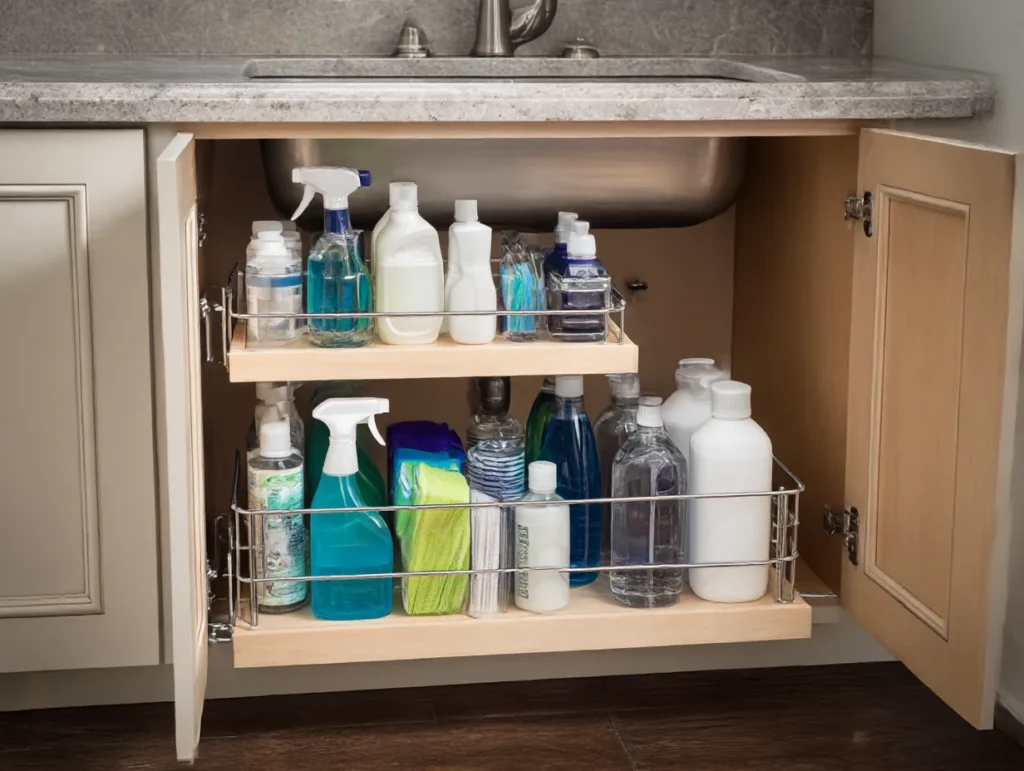
-
What they are: Two stacked trays that pull out together
-
Best for: Under-sink chaos, cleaning supplies, tall bottles
-
Pros: Maximizes vertical space, feels super organized
-
Cons: Can be tricky around plumbing, the bottom tray is usually smaller
-
Maya’s take: Feels like a grown-up move. Just watch out for your pipes.
4. Soft-Close, Full-Extension Slides
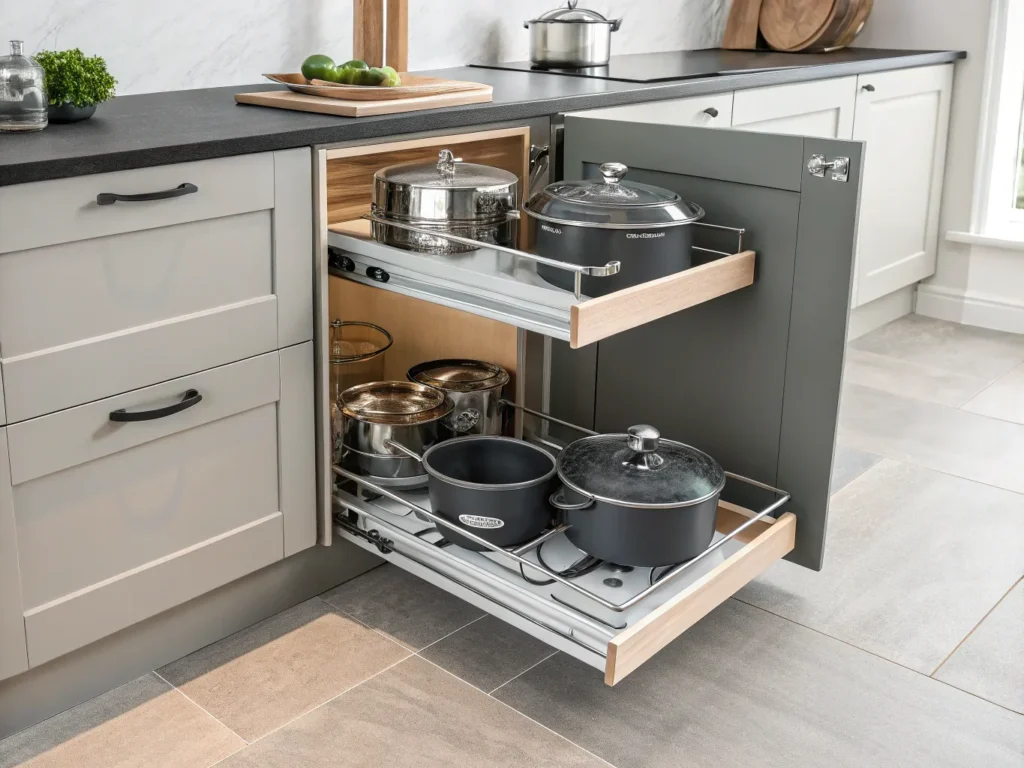
-
What they are: Glide systems that let trays pull all the way out and close gently
-
Best for: Base cabinets with heavy stuff
-
Pros: Super smooth, lets you see everything, satisfying AF
-
Cons: Costs more ($80+ per shelf), needs sturdier cabinet frames
-
Maya’s take: I splurged on one for our pots. No regrets. Even my husband noticed.
Which One Should You Get?
Here’s the thing: it depends on what drives you most nuts.
-
Tired of rummaging for snack bags? Wire baskets.
-
Want things to look nice? Wood trays.
-
Need more height? Double-tier it.
-
Want the fancy-smooth feel? Go full-extension with soft-close.
If you’re like me, start small, one shelf, one cabinet. See how it feels. Worst case? You return it. Best case? You finally find the colander without swearing
The First Time I Tried to Install One Spoiler, I Measured Wrong
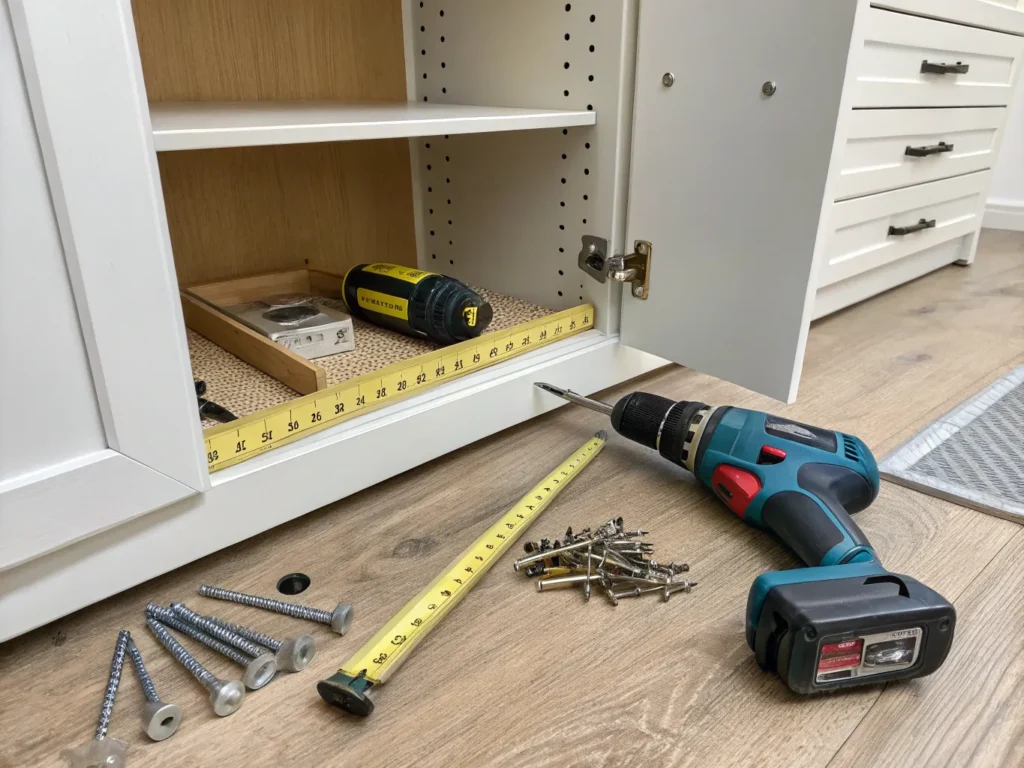
Okay. Real talk?
The first time I tried to install cabinet pull-out shelves, I got cocky. I watched two YouTube videos, scribbled down some numbers on the back of a grocery list, and decided I was totally ready. (Narrator: She was not.)
I chose the base cabinet under the microwave because it’s where every oddly shaped baking dish I own likes to go hide. I had my new wire pull-out shelf, my drill (half-charged, naturally), and a deep sense of optimism. Fast forward 40 minutes, and I’d drilled two sets of holes, both wrong, because I measured from the door edge instead of the cabinet opening.
Learn from me: always measure inside the cabinet frame, not the doors. Those hinges? Liars. They steal space.
Tools I Used And Should’ve Double-Checked First
-
Tape measure (I had three, all slightly different)
-
Drill (battery died halfway through, of course)
-
Level (which I found in the garage after I needed it)
-
Pencil
-
Cheap painter’s tape to mark spots, highly recommend
How Long Did It Take?
It should’ve been 30 minutes. Took me two hours. Why?
-
I drilled one bracket upside down
-
The shelf bumped into a hinge
-
I had to run back to Home Depot to get shorter screws
The upside? Once I got it in and saw the tray glide out with zero resistance, I may have done a little dance. I’m not proud, but I was giddy. It felt like I’d finally taken control of one corner of the kitchen.
How Much Did It Cost?
-
Shelf kit: $42.99 at Home Depot (Rev-A-Shelf wire version)
-
Extra screws + brackets because I messed up $5.23
-
Time + pride: Variable, but manageable
If I’d hired someone to install it, it probably would’ve cost $100+, and I wouldn’t have gotten that satisfying “I did it!” moment (or the lesson in measuring shame
Best Pull-Out Shelf Picks for Different Cabinets Based on Real Life, Not Showrooms
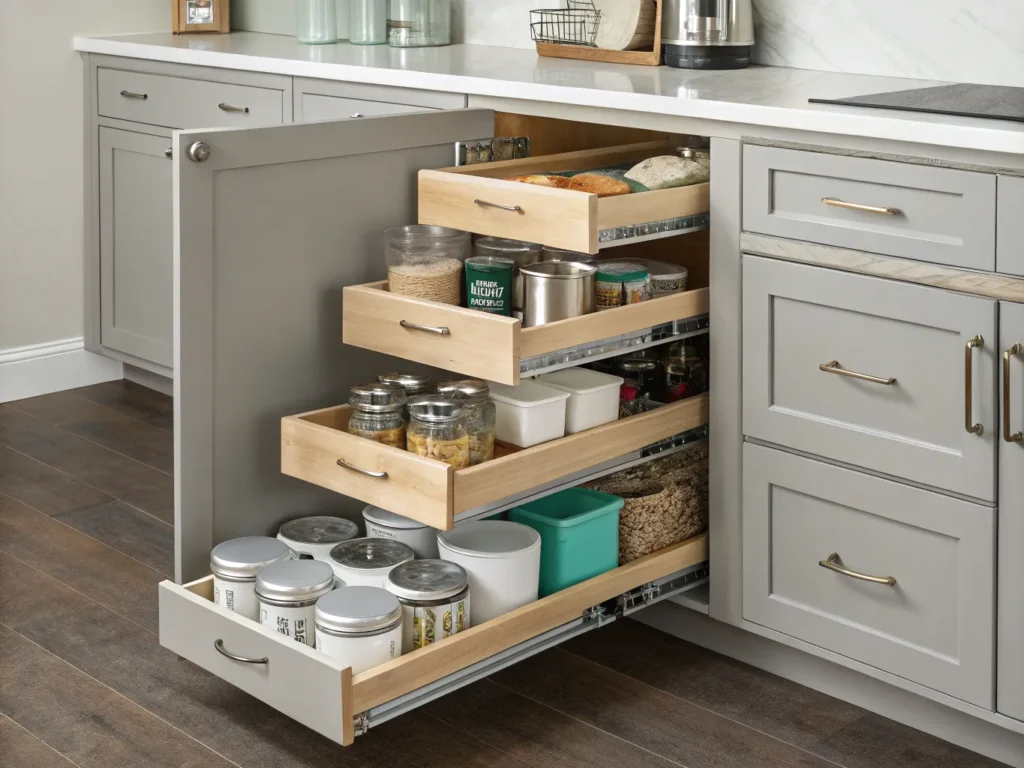
I’ve tested more cabinet pull-out shelves than I care to admit, some winners, some that made me question every choice I’d made since 2019. But over time (and several returns, I figured out what works where.
Here are my go-to picks, broken down by cabinet type, because what works under the sink doesn’t work in a pantry full of bulk couscous.
Under the Sink: The Plumbing Maze
-
Pick: Rev-A-Shelf 2-Tier Under Sink Organizer $78 at Lowe’s
-
Why it works: The L-shaped tier leaves space for pipes bless
-
What to know: Measure around your plumbing first, not after you’ve opened the box like I did.
-
Maya’s note: I had to shift it one inch right to dodge a pipe, but it still fits like a glove.
Pantry Cabinet, Tall and Chaotic
-
Pick: Simple Trending 2-Pack Pull-Out Baskets ($39.99 on Amazon)
-
Why it works: They’re long, stackable, and lightweight.
-
What to know: Not made for heavy stuff, but they make snack sorting easy.
-
Maya’s note: Perfect for kid snacks. Bonus: my kids put things back in them. Shocking, I know.
Corner Base Cabinet: The Bermuda Triangle of Kitchens
-
Pick: Rev-A-Shelf Half Moon Lazy Susan Pull-Out around $145
-
Why it works: Swings out and around so you can see stuff.
-
What to know: Not cheap, and takes a little courage to install.
-
Maya’s note: My neighbor Linda helped me figure it out; she deserves a medal.
Upper Cabinets: Lightweight and Narrow
-
Pick: Home Zone Pull-Out Spice Rack Organizer $26 on Amazon
-
Why it works: Fits small spaces, holds spices upright.
-
What to know: Only works if your shelf depth is 10″+
-
Maya’s note: It made me feel like the kind of person who alphabetizes their paprika.
A Quick Note on Renter-Friendly Options
If you’re in a rental or just don’t want to drill, look for adhesive-mounted or freestanding organizers. I tested one from YouCopia that sat on the cabinet floor with zero installation. It wasn’t life-changing, but for $32, it bought me breathing room and zero spackle needed
Rookie Mistakes I Made So You Don’t Have To
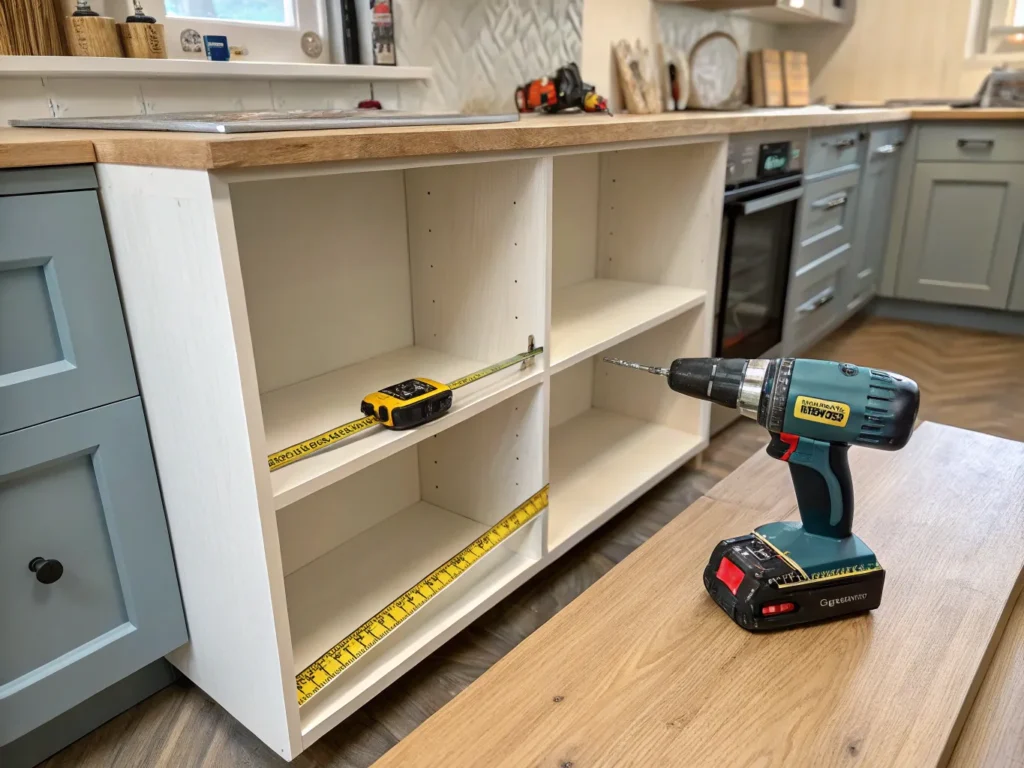
You know how some people learn by reading manuals? I am… not one of those people. I learn by doing, and by doing it wrong the first time. If you’re about to install cabinet pull-out shelves, let me spare you a few bruises (emotional and actual).
1. Measuring from the Door Frame, Not the Cabinet Opening
I was so proud of my measurements until I slid in the tray and it smacked the inside wall. Why? I measured from the outside of the cabinet, forgetting that the frame and hinges steal at least half an inch.
Fix: Measure inside the box, hinge to hinge, side to side, and front to back. And double-check. With a different tape measure. Seriously.
2. Ignoring Hinge Interference
Turns out, not all hinges behave. Some bulky cabinet hinges swing inward just enough to block your shelf from sliding out.
Fix: Open the door fully, hold the tray in place, and manually test the slide before you drill anything. Ask me how I know.
3. Overloading the Shelf
On my first install, I loaded the tray with cast iron, a blender base, and two glass mixing bowls. The slides groaned like a haunted house.
Fix: Check the shelf’s weight rating. Most are good for 50–100 lbs, but cheaper ones like the $30 wire trays I bought are closer to 20–30. Keep it light, or go premium for heavy-duty storage.
4. Not Leveling Because Eh, It Looks Straight
It looked fine until I pulled it out, and my olive oil bottle rolled off like a log on a hill.
Fix: Use a level. Even if it’s just a bubble level from the junk drawer. One extra minute saves a year of cursing.
5. Rushing the Job at 10 PM on a Sunday
Let’s just say drilling while sleepy is not peak DIY strategy.
Fix: Give yourself daylight, a working drill battery, and no kids asking for snacks every three minutes. It’s not a quick task—it’s a “make your life easier” investment.
Bonus Tip: Save the Screws from Your First Fail
You might need them later when your second tray works better. Or when you gift your mistake shelf to a friend who “kind of wants one too.
Cabinet Pull-Out Shelves vs. Drawer Conversions, Which One’s Smarter?

When I first started this whole cabinet makeover journey (read: mild chaos with a side of sawdust), I kept waffling between two ideas: do I install cabinet pull-out shelves? Or do I rip out the base cabinets entirely and go full drawer conversion?
Short answer? It depends on your sanity levels, your budget, and how emotionally attached you are to your cabinet boxes.
Pull-Out Shelves: The Low-Lift Fix
-
Effort: Moderate (measure, drill, level, but no demo)
-
Cost: Around $30–$90 per shelf, depending on style
-
Best for: Quick wins, renters, or anyone wanting more access without ripping out boxes
-
Drawbacks: You lose an inch or two of interior space for the slides; you still have to open cabinet doors and pull the tray
Maya’s take: Ideal if you’re trying to make what you’ve got work better. My kitchen still has all original cabinets, and these shelves make them feel way more modern without a full gut job.
Drawer Conversions: The Big Upgrade
-
Effort: High, usually requires a pro or serious tools
-
Cost: $300+ per cabinet if you hire it out
-
Best for: Full remodels, accessibility needs, or if your cabinets are falling apart anyway
-
Drawbacks: Expensive, time-consuming, and a one-way ticket, there’s no going back
Maya’s take: We considered drawers when we thought about redoing the whole kitchen… and then remembered we have two kids, one mortgage, and no emotional bandwidth for cabinet surgery.
So Which Should You Pick?
-
If you’re in a rental or want a low-commitment change → pull-out shelves
-
If you’re already remodeling or hate your cabinets → drawer conversions
-
If your back is screaming but your wallet is whispering → start with one shelf and see how it feels
Me? I’ll probably always be on Team Pull-Out. It’s like giving your cabinets a second chance, without needing a sledgehammer
FAQs from Friends Who’ve Seen My Cabinets Since
I swear, ever since I installed those cabinet pull-out shelves, my kitchen’s gotten more attention than when I painted the island blue. People come over, open one door, see the tray glide out, and suddenly I’m getting questions.
Here are the most common ones I’ve been asked (usually with wide eyes and a “wait, where’d you get that?” vibe).
How much do cabinet pull-out shelves cost?”
Totally depends. I’ve found basic wire ones for around $30, mid-range wood trays for $50–$70, and soft-close beauties that’ll run you $80+. You can get a full cabinet converted for $200+, but honestly? Start small. One shelf can make a difference.
Are they hard to install?
Depends on your confidence level with a drill and how often you yell at measuring tape. My first install took two hours and one trip to Home Depot. The second? Thirty minutes and no swearing. If you can assemble IKEA furniture, you’ve got this.
Do they hold up over time?
The wire ones? So far, so good. I installed mine over a year ago, and they still slide smoothly. The wood ones feel sturdier and have aged better, especially with heavier stuff. Just don’t overload them with cast iron and you’re golden.
What cabinet should I start with?
Pick the one that annoys you most. For me, it was the bottom base cabinet near the stove, always chaotic, always full of Tupperware with no lids. Fixing that one made my whole kitchen feel calmer
Are pull-out shelves worth it
Short answer: 100% yes. Long answer? It depends on your expectations. If you’re dreaming of a magically organized kitchen overnight, maybe pump the brakes. But if you want daily frustration to turn into “oh, that was easy,” they’re absolutely worth the $30–$80 investment. I smile every time I grab my salad spinner without knocking over the slow cooker. That’s a win in my book.
How much weight can a roll-out shelf hold?
Most standard ones can handle 50–100 pounds. Wire trays? Closer to 20–30. Wood or soft-close models? Stronger, especially the pricier ones. I tested mine with a blender, four cast iron pans, and some misplaced confidence, and while nothing broke, I did promptly remove two of those pans.
What do you call a pull-out shelf?
Officially? “Roll-out shelf,” “sliding tray,” or “cabinet pull-out organizer.” But I usually just say “those shelves that save my sanity.” Most brands will use a mix of terms; just look for anything that glides out and doesn’t require a sledgehammer to install.
What cabinet should I start with?
Pick your kitchen’s pain point. For me, it was the bottom cabinet where mismatched Tupperware went to die. Fixing that made every meal-prep session way less ragey
So… Are Cabinet Pull-Out Shelves Worth It? My Final Take
Here’s the thing: cabinet pull-out shelves didn’t change my life. They didn’t teach my kids to put dishes away or make dinner magically appear.
But they did make my kitchen feel 10% easier to live in. And some days? That’s enough.
After installing a few (and messing up a couple), I realized it’s not about making your space Pinterest-perfect. It’s about finally being able to grab your Dutch oven without knocking over three cereal boxes and a rogue whisk. It’s about making the kitchen work for you, even if the cabinets aren’t brand new and the hinges squeak a little.
Would I do it again? Absolutely. I already have, three more times.
So if you’ve been wondering whether cabinet pull-out shelves are worth it, here’s my honest advice: start small. One cabinet. One tray. See how it feels. Worst case? You return it. Best case? You feel like an actual kitchen wizard every time you reach for your mixing bowl

